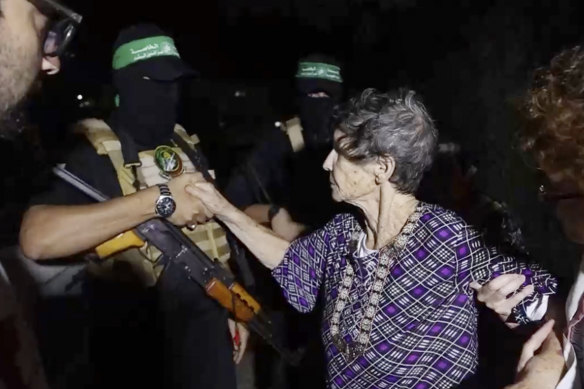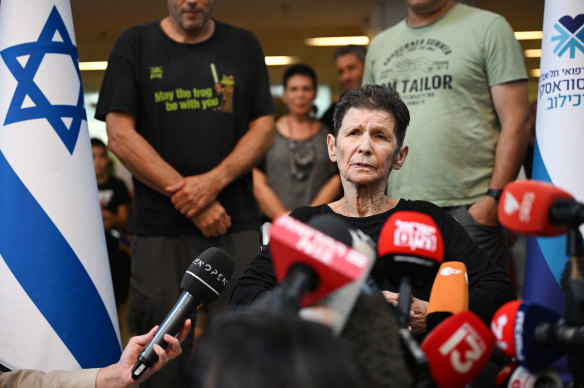Save articles for later
Add articles to your saved list and come back to them any time.
It was a moment of grace in an ocean of hatred and belligerence.
As Israeli hostage Yocheved Lifshitz was released by Hamas under cover of darkness to Red Cross workers on the Egyptian border, the 85-year-old turned to one of her gun-wielding captors and shook his hand.
“Shalom,” she repeatedly told the masked terrorist wearing a balaclava and bulletproof vest emblazoned with a Hamas flag.
Her use of the Hebrew greeting word, which translates literally as “peace”, to one of her captors seemed to mark a rare kind of character.
The man whose hand she shook was, after all, part of the group who slaughtered 1400 Israelis on October 7 and took 200 hostage.
But the gesture was fitting for a woman who, along with her husband, 83-year-old Oded, has been a peace activist all her life.
Lifshitz was released alongside 79-year-old Nurit Cooper on Monday night.
At a press conference on Tuesday, a frail-looking Lifshitz told the world of the “hell” she went through as a captive.
Sitting in a wheelchair in a hospital in Israel she said she was robbed and beaten with a stick by her captors, but also described them as “courteous”, offering her pita sandwiches and shampoo.
“I went through a nightmare we couldn’t have imagined,” she said, stuttering as she spoke while her British daughter crouched next to her, translating into English.
“They put me on a motorbike, took me through that fence that cost 2 billion shekels ($775 million) and did not help one bit. As we rode, the motorcycle driver hit me with a wooden stick. They didn’t break my ribs but it hurt a lot, making it difficult to breathe.”
This image taken from video released by Al Qassam brigades on its Telegram channel, shows Yocheved Lifshitz, 85, shaking hands and thanking a member of Hamas as she is released to the Red Cross.Credit: Al Qassam
Lifshitz’s account gives extraordinary insight into the terrorists’ preparation and their network of underground hiding places.
After the captors took Lifshitz and other hostages deep into Gaza, they took off her watch and jewellery as they dismounted the bike and led her away until they reached Hamas’ infamous tunnels.
“We went underground and walked for kilometres in wet tunnels – for two or three hours in a spiderweb of tunnels,” she told reporters at the hospital as staff kept bringing her cups of water.
She said she saw about 50 other hostages in one room, and soon she and four other people were led to a different room.
Unlike on the way into Gaza, the captors in the tunnels treated them well, she said.
“They were friendly, they took care of us,” she said. “One of the hostages was badly injured from a motorbike accident, and they gave me antibiotics and other medicine.”
She described her captives as “very friendly” and “very courteous” people who had organised well in advance for taking hostages.
“They seemed ready for this, they prepared for a long time, they had everything that men and women needed, including shampoo,” she said.
“We ate the same food they did – pitas with cream cheese, melted cheese, cucumbers. That was a meal for an entire day,” she added.
Hamas released the two women late on Monday, citing “compelling humanitarian reasons” without offering any other details. The remainder, including the elderly and children, are still held captive without a clear prospect of return.
When Lifshitz said “shalom” to her captors, the Hamas gunman replied with the word “salamtek”, which means “take care”.
Talk of peace after the Hamas massacre in which her house was destroyed and her friends killed may sound incongruous.
Since the attack, at least 5087 Palestinians have been killed in two weeks of Israeli strikes, including 2055 children, according to the Hamas-run Health Ministry.
But Lifshitz is no armchair peacenik.
She and her husband, who remains a Hamas hostage along with Cooper’s spouse, are “human rights activists, peace activists for all their life”, her grandson Daniel Lifshitz said.
“For more than a decade, they took … sick Palestinians from the Gaza Strip, not from the West Bank, from the Gaza Strip, every week from the Erez border to the hospitals in Israel to get treatment for their disease, for cancer, for anything,” he said.
The couple were residents of Nir Oz kibbutz, one of the Israeli communities near the Gaza Strip which Hamas militants attacked on October 7.
Lifshitz’s daughter Sharone, an artist and academic in London, said: “I’m so proud of her. She is amazing. Just the way she walked off and then came back and said thank you is quite incredible to me. It’s so her.
Yocheved Lifshitz speaks to the media outside Ichilov Hospital.Credit: Getty
“There are still over 200 people there. And we must not get caught only in our personal happiness but work towards the release of everybody.
“This is one small ray of light. But there is a huge darkness. The war is still going on. Atrocities we haven’t even started to process.”
As for her father, she said: “[He] was very involved in political things in the kibbutz. He was very involved in rights for Palestinians and working towards peace with our neighbours.
“His whole life was to find a way to live together. He felt it was very easy to find a way and was very disappointed and fought very hard against this idea of occupation and perpetual war.
“It’s a tragedy that the people who were killed, so many of them were immediate neighbours of people of Gaza and truly, truly believed in working towards peace with our neighbours and felt that it was very possible to make peace with our enemies.
“It’s a twist of history that these communities that were really peace-loving … are the ones who sustained such a horrendous massacre.”
Have she or her parents given up on finding peace with their neighbours?
“No … We have come out of the Holocaust. I have worked extensively in Germany and have many German friends. We have to find a way. There is no alternative. If anything, it makes me even more resolved. The way has got longer … [but] as nations we have to find a way forward.”
The Telegraph, London
More coverage of the Hamas-Israel conflict
- Cascading violence: Tremors from the Hamas attacks and Israel’s response have reached far beyond the border. But what would all-out war in the Middle East look like?
- The human cost: Hamas’ massacre in Israel has traumatised – and hardened – survivors. And in Gaza, neighbourhoods have become ghost cities.
- “Hamas metro”: Inside the labyrinthine network of underground tunnels, which the Palestinian militant group has commanded beneath war-ravaged Gaza for 16 years. The covert corridors have long provided essential channels for the movement of weapons and armed combatants.
- What is Hezbollah?: As fears of the conflict expanding beyond Israel and Hamas steadily rise, all eyes are on the militant group and political party that controls southern Lebanon and has been designated internationally as a terrorist group. How did it form and what does Iran have to do with it?
Get a note directly from our foreign correspondents on what’s making headlines around the world. Sign up for the weekly What in the World newsletter here.
Most Viewed in World
From our partners
Source: Read Full Article


